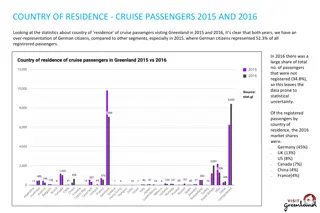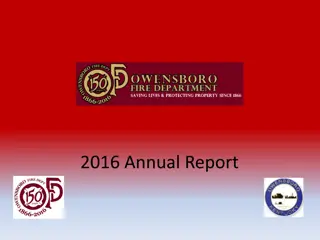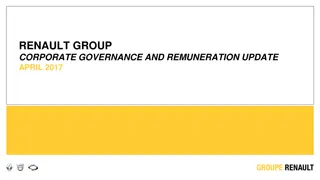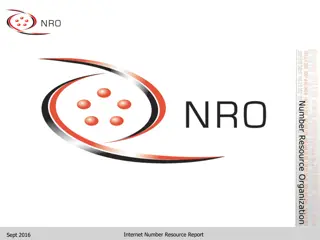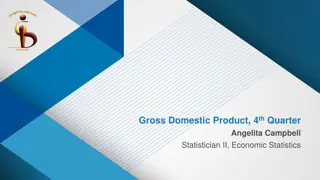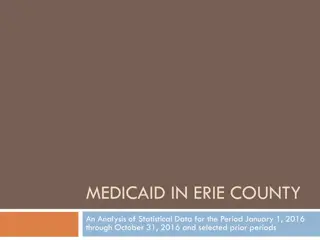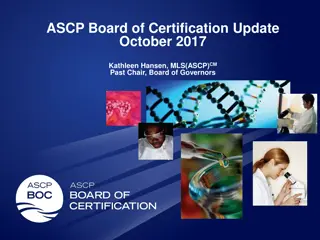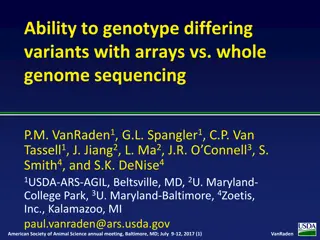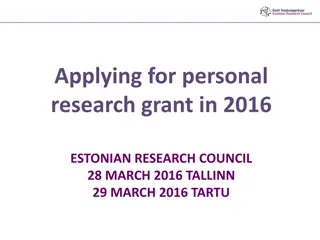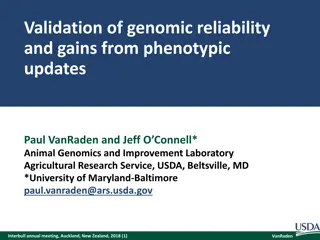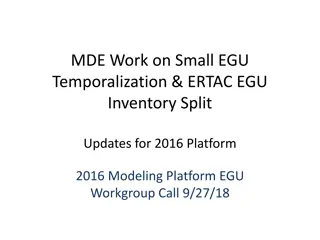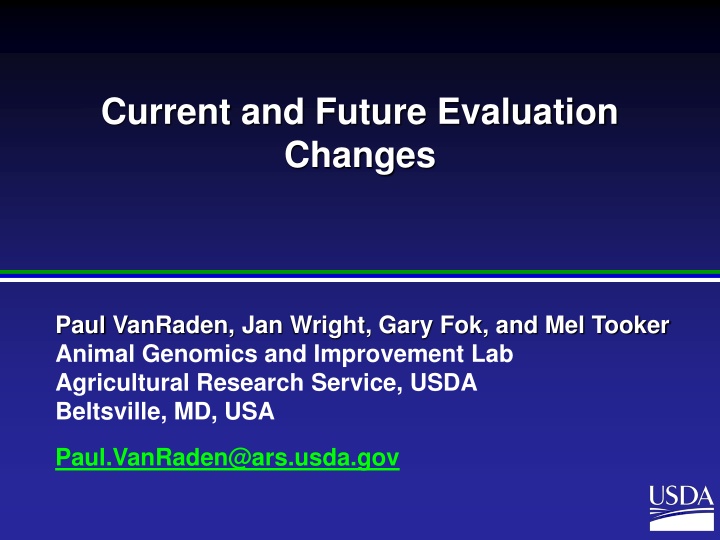
Evaluation Changes in Animal Genomics and Improvement Lab Research
Explore the current and future evaluation changes in animal genomics and improvement research conducted by Paul VanRaden and team. Topics covered include breed check markers, predicting breed as a trait, and GPTA for crossbreds. Discover the advancements and methodologies employed in genomic evaluation for breeding programs.
Uploaded on | 1 Views
Download Presentation

Please find below an Image/Link to download the presentation.
The content on the website is provided AS IS for your information and personal use only. It may not be sold, licensed, or shared on other websites without obtaining consent from the author. If you encounter any issues during the download, it is possible that the publisher has removed the file from their server.
You are allowed to download the files provided on this website for personal or commercial use, subject to the condition that they are used lawfully. All files are the property of their respective owners.
The content on the website is provided AS IS for your information and personal use only. It may not be sold, licensed, or shared on other websites without obtaining consent from the author.
E N D
Presentation Transcript
Current and Future Evaluation Changes Paul VanRaden, Jan Wright, Gary Fok, and Mel Tooker Animal Genomics and Improvement Lab Agricultural Research Service, USDA Beltsville, MD, USA Paul.VanRaden@ars.usda.gov Paul.VanRaden@ars.usda.gov 2007 2016
April changes HO genotypes from Switzerland Genomic evaluation of Guernseys Mutations in HCD and in BH2 HCR edits and adjustments Breed base representation (BBR) for crossbreds Paul VanRaden Select Sires sire committee meeting, March 21, 2016 (2)
Breed check markers Breed determining SNP introduced in 2010 200 SNPs monomorphic in 1 breed and have fewer than 30% of animals homozygous for that allele in another breed Initially used to identify misidentified samples Later, used to exclude crossbreds from genomic evaluation because purebred equations did not apply accurately Currently, about 10,000 crossbreds excluded with cost of genotyping about $400,000 Paul VanRaden Select Sires sire committee meeting, March 21, 2016 (3)
Predicting breed as a trait Reference population is purebred, proven bulls Variable to predict (Y) is breed of animal Holstein bulls are coded 100% HO, 0% JE, and 0% BS, for example Animal Breed Holstein percent Jersey percent Brown Swiss % HO 100 0 0 JE 0 100 0 BS 0 0 100 Paul VanRaden Select Sires sire committee meeting, March 21, 2016 (4)
Results from 2010 (Katie Olson) Means and standard deviations to predict breed of the validation (young animals) data set Breed /SNP set 43 K 3 K 600 Holstein (N = 14,794) 100.0 0.8 100.4 3.1 100.2 1.9 Jersey (N = 919) 99.6 2.8 97.8 6.3 98.9 3.6 Brown Swiss (N = 96) 99.4 2.1 98.9 3.6 99.2 5.1 Paul VanRaden Select Sires sire committee meeting, March 21, 2016 (5)
GPTA for crossbreds (proposed) Compute traditional PTAs on all-breed base Calculate SNP effects using each pure breed s genotypes, but on all-breed base Apply each breed s SNP effects (AY, BS, GU, HO, JE) to the crossbred genotypes Combine individual breed GPTAs weighted by genomic breed composition Convert GPTAs to within-breed base Paul VanRaden Select Sires sire committee meeting, March 21, 2016 (6)
Cow mortality / livability Reasons for disposal have been reported and stored in DHI records since 1970 About 20% of cows die instead of being sold across all lactations Death loss per lactation average 7%, higher in later, lower in earlier lactation Paul VanRaden Select Sires sire committee meeting, March 21, 2016 (7)
Productive Life (PL) vs. Livability (LIV) PL measures cow s ability to avoid dying or being culled LIV measures cow s ability to stay alive LIV is a subset of PL Cost = 1500 pounds * $.75 / pound + $50 disposal = $1200 / death Paul VanRaden Select Sires sire committee meeting, March 21, 2016 (8)
LIV model Definition: Reverse of mortality: 0 = died this lactation 100 = lived this lactation Multiply by average lactation/cow (2.8) so to put on lifetime scale Paul VanRaden Select Sires sire committee meeting, March 21, 2016 (9)
LIV model (cont.) Data: 92 million records on 32 million cows Methodology: Same model and software as other major traits Similar edits as other traits Multi-trait with overall culling per lactation, but lactation cull rate will not be reported Heritability of 1.3 (Miller et al., 2008), genetic correlation with lactation PL of .50 Paul VanRaden Select Sires sire committee meeting, March 21, 2016 (10)
Means and Std Dev. of PTALIV (bulls born 1990 or later, minimum 50 daus, .50 rel for PTALIV) Breed AY BS GU HO JE MS Mean 0.5 0.1 -0.3 -1.1 -0.2 0.7 Std Dev 2.0 2.0 3.5 2.2 1.7 1.9 Num. bulls 246 692 182 45,840 3,893 64 Paul VanRaden Select Sires sire committee meeting, March 21, 2016 (11)
Correlation of PTALIV with other trait PTAs (bulls born 1990 or later, minimum 50 daus, .50 rel for PTALIV) Trait Milk Fat Protein Prod. Life SCS Dau. Preg. Rate Cow Conc. Rate Heifer Conc. Rate Num. bulls HO .09 .21 .16 .70 -.28 .40 .40 .28 45,840 JE -.08 .01 -.01 .54 -.07 .54 .33 .32 3,893 Paul VanRaden Select Sires sire committee meeting, March 21 2016 (12)
LIV genetic trends 1970-2013 Paul VanRaden Select Sires sire committee meeting, March 21 2016 (13)
Genetic trend in PTALIV - HO 1.5 1.0 0.5 0.0 -0.5 LIV EBV -1.0 -1.5 -2.0 -2.5 -3.0 -3.5 1970 1975 1980 1985 1990 1995 2000 2005 2010 2015 Cow birth year Paul VanRaden Select Sires sire committee meeting, March 21 2016 (14)
Added value from more traits Year 1976 1994 2000 2003 Traits 3 5 18 21 Added Protein Productive life, SCS Size, udder, feet / legs Pregnancy rate, calving ease (sire, dtr) Stillbirth (sire, dtr) Heifer, cow conception Cow death 6 more health traits Data DHIA DHIA Breeds DHIA / NAAB NAAB DHIA DHIA Zoetis Corr .96 .84 .94 .98 Gain 4% 19% 6% 2% 2006 2014 2016 2016 23 25 .98 .97 > .99 .92 ?? 2% 3% < 1% 21% ?? 31 Paul VanRaden Select Sires sire committee meeting, March 21, 2016 (15)
Health trait cases and costs? Trait Cases (%) / lactation 7 23 20 10 5 2 5 Heritability (obs / thr)3 1.3 / 4.8 3.7 / 6.9 3.7 / 6.3 2.9 / 5.9 2.6 / 7.3 1.5 / 8.1 2.1 / 5.9 Cost ($) / case 1,200 200 320 330 250 250 200 Death1 Mastitis2 Lameness Metritis Retained Placenta Displaced Abomasum Ketosis 1Death data from USDA research 2Other trait cases and cost from Zoetis data and advertisement 3Observed scale and equivalent underlying (threshold model) heritability Paul VanRaden Select Sires sire committee meeting, March 21, 2016 (16)
Correlations of SCS and mastitis Correlation CAN DFS FRA NLD USA SCS, foreign MAST USA SCS, foreign SCS .87 .94 .87 .88 .87 .90 .88 .88 Genetic correlations estimated by Interbull, Apr 2016 Genetic correlation (SCS,MAST) estimated by Zoetis = .45 Paul VanRaden Select Sires sire committee meeting, March 21, 2016 (17)
Genotyped mates and ET progeny Percentages for top young NM bulls, Dec 2015 100 90 Percent (offspring or mates) 80 70 60 50 40 30 20 10 0 800 825 850 875 900 925 950 Net Merit (Dec 2015) Percent mates genotypes Percent offspring ET Paul VanRaden Select Sires sire committee meeting, March 21, 2016 (18)
Future evaluation options Single-step genomic equations OK for JE, still not for HO Traits already recorded Age at first calf, gestation length, persistency, heat tolerance Traits requiring new data Feed efficiency, health, etc. Sequence mutations plus markers Paul VanRaden Select Sires sire committee meeting, March 21, 2016 (19)
History of SNP Chips Paul VanRaden Select Sires sire committee meeting, March 21, 2016 (20)

